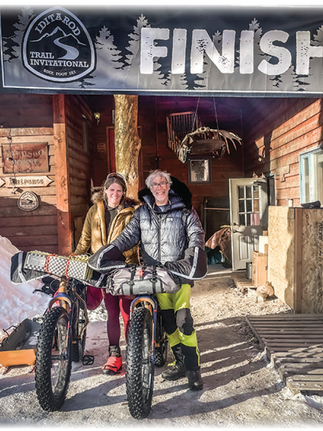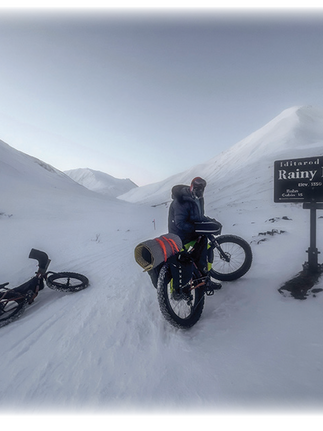Paul Gagner and Sunny Stroeer recently rode the Iditarod Trail Invitational in Alaska for 350 miles. Gagner and his wife, Stroeer, own Dreamland Safari Tours in Kanab and are veterans of a variety of outdoor activities.
The Iditarod is better known as a Sled Dog race and is 938 miles from Anchorage to Nome, entirely within the state of Alaska. The name Iditarod comes from the Athabaskan village of Iditarod in the early 20th century. The Iditarod Trail Invitational (ITI) is considered a pinnacle race for endurance athletes and is the human powered version of the more famous dog sled race. According to the ITI website: “With jagged mountain ranges, bonenumbing temperatures and minimal support, the ITI 350 forces competitors to reach deep within themselves to persist while being besieged by relentless physical and mental challenges.”
All photos by Sunny Stroeer.
Each athlete has 10 days to complete the 350 mile race, and 30 days to complete the 1000 mile race. The routes follow the historic Iditarod trail through the Alaska wilderness. Athletes apply to complete either length race on foot, skis, or fat-tired mountain bikes. Out of a total of 97 participants, thirteen racers completed the 1000 mile race, 38 completed the 350 mile race and 46 participants did not complete the race.
For the last two years, Stroeer has finished the 350 mile version of the race on skis. In February of 2023 Stroeer and Gagner participated in the 350 mile version on mountain bikes. Alaska was no less cold and snowy than the rest of the country and temperatures reached minus 40 degrees, which happens to be the same number in both Fahrenheit and Celsius. According to Gagner, “The extreme cold caused an unusually high ‘scratch’ rate where racers drop out.” Many this year dropped out due to frostbite and he plans to do the 350 miles on a bicyle again and Stroeer intends to be the first person to complete the 1000 mile trail on skis in less than 30 days. No one, man or hypothermia. Gagner did get a tiny bit of frostbite on his left thumb, but that has already mostly healed since the race. Participants came from around the world. The couple completed the race together in eight days seven hours and five minutes, including one rest day. The overall fastest time of three days one hour and 30 minutes was by Tyson Flaharty of the United States. The fastest woman racer, Kinsey Loan of the United States, completed the race in five days 13 hours and 27 minutes. The fastest time for the 1000 mile race was 16 days 21 hours and 29 minutes.
Lodges, and checkpoints along the way offer lodging and support. Some lodging places are nice and others are more primitive. Racers still bring winter camping gear and camp out when other options are not available or if they cannot get to lodging because of the weather.
Riding at night, to keep from falling through the snow and ice, the team started racing at 2 p.m., and rode 55 miles to Yentna Station around 5:30 a.m. On that first night out, they were blessed to see a full night of aurora borealis, or northern lights. According to Gagner, the locals in Anchorage said it was the best northern light display in 20 years.
On the fifth day of their trek, they rode their bicycles over Rainy Pass into Alaska’s interior. Gagner said that a ground blizzard with 25-30 mile an hour winds forced them to push their bikes for much of the 18 mile climb to the pass.
Gagner doesn’t generally consider himself an ‘endurance athlete’ and has far more experience with climbing. The brutally cold weather, wind and snow, deep fatigue, were somewhat balanced with beautiful scenery. Stoerr and Gagner were “stoked to cross the finish line together.”
Asked whether Gagner or Stroeer would do the race again, Gagner said woman, has completed the 1000-mile trails on skis before. For more information about the Iditarod Trail Invitational, visit itialaska.com.













